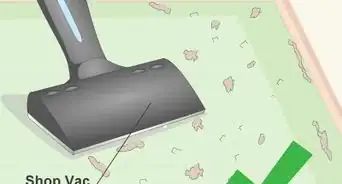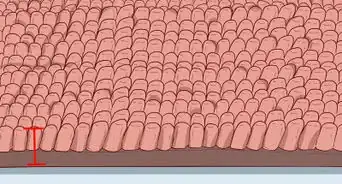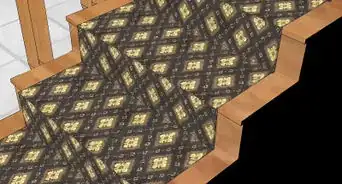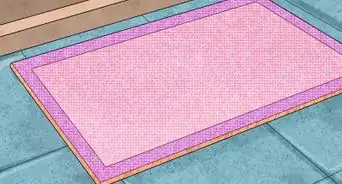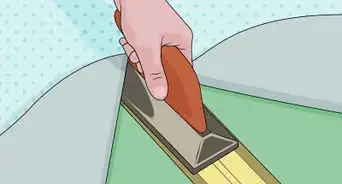This article was co-authored by Mark Spelman. Mark Spelman is a General Contractor based in Austin, Texas. With over 30 years of construction experience, Mark specializes in constructing interiors, project management, and project estimation. He has been a construction professional since 1987.
wikiHow marks an article as reader-approved once it receives enough positive feedback. In this case, 95% of readers who voted found the article helpful, earning it our reader-approved status.
This article has been viewed 390,904 times.
Whether doing it for aesthetic reasons or to help warm up a cold room, carpeting concrete floors is something most people can do in a day or two. Why pay someone else to do it? By learning to prep the room for carpeting and using the right materials, you'll ensure that the job will go quickly and smoothly.
Things You Should Know
- Measure your room and pick a carpet that will stand up to concrete, suit your lifestyle, and match your drapes and paint.
- Before you install the carpet, empty the room of its furniture and doors, check for moisture problems, air out your carpet, and prepare the concrete.
- Lay a tack strip and padding strips before cutting the carpet, forcing it into the corners of the room, and finishing the edges.
Steps
Buying Carpet
-
1Measure the room to be carpeted. Take these measurements to your carpet dealer to make sure you get an ample amount of carpet for your job. Be sure to tell them that you are carpeting over concrete since that requires different carpet material as well as slightly different tools than carpeting over wooden surfaces.
-
2Bring any drape or paint samples to the carpet dealer for comparison. If you've already painted the walls or planned for any other decorating in the room, take in some samples of the colors so you can make an informed choice at the store.Advertisement
-
3Prepare for the dealer's questions. Typically, you'll be asked some basic questions about the room and your intended use for the room. These questions are designed to help you pick the most appropriate carpet, and are good questions to ask yourself anyway. It helps to give some thought beforehand so you don't have to make a hasty decision.[1] A dealer may ask:
- Are there a lot of windows in the room?
- Will there be heavy or light traffic in the room?
- Do you have kids or pets?
- Is there direct access from outside?
- How large is the room?
- Dealers will also typically try to sell you on Stainmaster, Teflon, and Anti-Static technology at various levels of expense to you. Remember, the decision's up to you. Get something that'll serve your purpose, but don't get pushed into expensive options you don't want.
-
4Select a carpet that will stand up to the concrete. Make sure the entire carpet is constructed of synthetic products only. Some carpet is backed with jute, which is too absorbent to use on concrete. If you're not going to install your carpet on a subfloor, you'll need to make sure that you're picking a kind of fiber that will stand up to concrete's tendency to collect moisture.
- Consider carpet made from olefin face fiber. A chemical-resistant fiber that will stand up to aggressive cleaning solutions like bleach, this might not be the softest or most attractive carpet, but it will last.[2]
-
5Decide on a style of carpet. You can choose between patterned or solid carpet, as well as a light or dark color. You can also choose tight or loose fiber loops and pick between a solid or mesh subsurface.
- Typically, the carpet rule of thumb is that light carpet can seem to create more space in a smaller room, while a darker shade of carpet can add coziness to a bigger space.
Prepping the Room
-
1Completely empty the room. Remove all furniture as well as anything else that rests on the carpet.
-
2Check the room for moisture problems. Any drainage issues in the room you're planning to carpet need to be addressed before carpeting. Ignoring the problem now could result in a costly and expensive project down the road, especially if you end up with harmful mold and end up having to tear out the carpet and repeat all your hard work.
- Rent or buy a moisture reader to test the humidity yourself.
- You should do this a week or more prior to carpet installation day to allow plenty of time for the waterproofing to be done.
-
3Air out the carpet out before installation. Carpeting is a chemical soup full of solvents. Allowing it some time to air out will cut down on fumes when you install it.
-
4Remove any doors for ease of installation. You might have to sand down, or use a saw to undercut, the bottom of the doors and trim door jambs to ensure smooth closing after the carpet installation.
-
5Lift any baseboards. You may need to remove the baseboards in order to install your carpet. Alternatively, the carpet may fit under the baseboards; in that case you can leave them in place.
-
6Fill in any cracks or imperfections in the surface. Before the surface dries, fill in any holes or cracks, making sure the top of the repair is level with the rest of the concrete surface. Small cracks and fractures can be fixed using a cement based, waterproof filler (e.g., Armstrong 501).
-
7Use a leveling product to flatten any low spots in the slab. Be sure to let the product dry, then sand and smooth the surface.
-
8Clean the concrete thoroughly, using the appropriate cleaner for the stains you find. Follow the washing with a mold and bacteria killing solution of 1 part household bleach to 15 parts water. Rinse thoroughly with clean water.
-
9Control the temperature in the room. For about 48 hours prior to and after installation, the temperature should stay between 65°F and 95°F (18°C and 35°C) and humidity between 10% and 65%. By observing these conditions, your carpet installation should go smoothly.
Laying Carpet
-
1Lay the tack strip. Cut a piece of tack strip the length of one wall, and attach it to the floor with masonry nails. The tack points should be facing the wall. You should also use a liquid nail glue along with the nails for a secure fit. Leave a gap the thickness of the carpet's pile between the gripper strip and the wall. This is where you will tuck the edges of the carpet during installation.
- Tack strip is also known as gripper rod (UK), carpet gripper, Smooth edge (Can), tack strip, and gripper edge.[3]
- Alternatively, you can use glue-down carpet, rather than tack strips.
-
2Lay padding strips. Cut padding strips the length of the room, and place them side by side across the room. Keep your rows abutted, and cover seams with duct tape. Trim any excess with a utility knife. Apply glue to the corners as well as to various spots throughout the body of the padding.
-
3Cut carpet to size, allowing approximately 6 inches (15.2 cm) excess all around. Patterns have to match in length to hide seams. Place seam tape, adhesive side up, where pieces abut. Use a steam iron to activate the adhesive and join the pieces together.
-
4Lay carpet out and use a rented knee kicker to force the carpet into the far corner. Using the power stretcher, stretch the carpet across the room to the opposite wall. Hook the carpet onto the tack strip. Continue this until the carpeting is smooth and flat.[4]
- Generally, you'll work from the centers of each wall toward the corners.
- As a novice, you might want to avoid using a power stretcher, since they can overstretch or even rip carpet. They are hydraulic, heavy, and very expensive.
-
5Finish the edges. Cut off excess carpet, and push carpet behind tack strip, using a wide blade putty knife if necessary. Cover edge of carpeting at doorways with metal door jambs and replace doors. Finish off with baseboards of your choice.
Warnings
- Always trim carpet from the back using a sharp carpet knife and a metal straight edge to ensure even cuts.⧼thumbs_response⧽
- Wear eye protection when hammering masonry nails into the concrete.⧼thumbs_response⧽
- Don't prime the floor unless it can be qualified. If moisture did get through the concrete, any kind of primer in the world would release and bubble.⧼thumbs_response⧽
Things You'll Need
- Carpet
- Padding
- Adhesive
- Carpet knife
- Duct tape
- Straight edge
- Tack strip
- Masonry nails
- Hammer
- Carpet stretcher
- Knee kicker
- Seaming tape
- Iron
- Putty knife
- Metal door jamb
- Cleaning supplies, such as a mop and bucket
References
About This Article
To install carpet on concrete, choose a carpet that is constructed of synthetic products only as natural fibers are often too absorbent. Before you install the carpet, make sure to check the concrete for any moisture issues that need to be addressed. Then, lay tack strips around the perimeter of the room and install your strips of padding. After that, lay your carpet, starting at the center of the room and tightening the carpet with a rented knee kicker as you move toward the walls. Finally, finish with your edges. For more from our Contractor reviewer on how to fix any leaks you find, read on!
-Step-1.webp)
-Step-2.webp)
-Step-3.webp)
-Step-4.webp)
-Step-5.webp)
-Step-6.webp)
-Step-7.webp)
-Step-8.webp)
-Step-9.webp)
-Step-10.webp)
-Step-12.webp)
-Step-13.webp)
-Step-11.webp)
-Step-14.webp)
-Step-15.webp)
-Step-16.webp)
-Step-17.webp)
-Step-18.webp)
-Step-19.webp)


